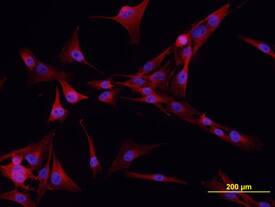Human Cadherin-6/KCAD Antibody
R&D Systems, part of Bio-Techne | Catalog # AF2715

Key Product Details
Species Reactivity
Validated:
Cited:
Applications
Validated:
Cited:
Label
Antibody Source
Product Specifications
Immunogen
Thr22-Ala615
Accession # P55285
Specificity
Clonality
Host
Isotype
Scientific Data Images for Human Cadherin-6/KCAD Antibody
Detection of Cadherin‑6/KCAD in MG-63 Human Cell Line by Flow Cytometry.
MG-63 human osteosarcoma cell line was stained with Sheep Anti-Human Cadherin-6/KCAD Antigen Affinity-purified Polyclonal Antibody (Catalog # AF2715, filled histogram) or control antibody (Catalog # 5-001-A, open histogram), followed by NorthernLights™ 557-conjugated Anti-Sheep IgG Secondary Antibody (Catalog # NL010).Cadherin‑6/KCAD in MG‑63 Human Cell Line.
Cadherin-6/KCAD was detected in immersion fixed MG-63 human osteosarcoma cell line using Sheep Anti-Human Cadherin-6/KCAD Antigen Affinity-purified Polyclonal Antibody (Catalog # AF2715) at 10 µg/mL for 3 hours at room temperature. Cells were stained using the NorthernLights™ 557-conjugated Anti-Sheep IgG Secondary Antibody (red; Catalog # NL010) and counterstained with DAPI (blue). View our protocol for Fluorescent ICC Staining of Cells on Coverslips.Applications for Human Cadherin-6/KCAD Antibody
CyTOF-ready
Flow Cytometry
Sample: MG-63 human osteosarcoma cell line
Immunocytochemistry
Sample: Immersion fixed MG-63 human osteosarcoma cell line
Western Blot
Sample: Recombinant Human Cadherin-6/KCAD Fc Chimera (Catalog # 2715-CA)
Formulation, Preparation, and Storage
Purification
Reconstitution
Formulation
Shipping
Stability & Storage
- 12 months from date of receipt, -20 to -70 °C as supplied.
- 1 month, 2 to 8 °C under sterile conditions after reconstitution.
- 6 months, -20 to -70 °C under sterile conditions after reconstitution.
Background: Cadherin-6/KCAD
The cadherin superfamily is a large family of membrane-associated glycoproteins that engage in homotypic, calcium-dependent, cell-to-cell adhesion events. The superfamily can be divided into at least four subfamilies based on its member’s extracellular (EC) regions and cytoplasmic domains (1, 2). These include classical cadherins, desmosomal cadherins, protocadherins, and cadherin-like molecules that contain a variable number of EC and transmembrane (TM) domains (1). Cadherin‑6, also known as KCAD or K-cadherin, is a classical cadherin of 110-120 kD that has at least one full length and two alternate splice forms ranging in size from 105‑120 kDa (3). Human cadherin-6 is synthesized as a 790 amino acid (aa) type I transmembrane glycoprotein that contains a 18 aa signal peptide, a 35 aa prosequence, a 562 aa extracellular region, a 21 aa transmembrane segment, and a 154 aa cytoplasmic domain (4, 5). There are five EC cadherin domains that are approximately 110 aa in length. This pattern is consistent with classical cadherin family molecules that are modular in their extracellular region and mediate calcium-dependent cell-to-cell adhesion through their Ca++-binding repeats (2). Due to the absence of a His-Ala-Val motif in its most N-terminal cadherin repeat, Cadherin-6 can be further classified as a type II classical cadherin (4). One cadherin-6 splice variant (termed 6/2) shows a 9 aa substitution for the 94 aa that span residues 283 to 376 of the full-length extracellular region (3). A second splice variant shows a 36 aa substitution for the C-terminal 163 aa of the transmembrane and cytoplasmic region (6). The extracellular region of human cadherin-6 is 98% aa identical to rat cadherin-6 extracellular region, plus 60% and 58% aa identical to the extracellular regions of human cadherin 8 and 11, respectively. Cadherin-6 has high expression in kidney, brain, and cerebellum, and low expression in lung, pancreas, gastric mucosa, and cytotrophoblasts (4, 5, 7-9). Cadherin-6 is also found in renal, lung, and ovarian carcinoma (7, 10). As a classic cadherin, cadherin-6 will form homodimers and promote intercellular adhesion with itself and possibly, cadherin-9 and -14 (4, 11).
References
- Koch, A.W. et al. (2004) Cell. Mol. Life Sci. 61:1884.
- Angst, B.D. et al. (2001) J. Cell Sci. 114:629.
- Mbalaviele, G. et al. (1998) J. Cell Biol. 141:1467.
- Shimoyama, Y. et al. (2000) Biochem. J. 349:159.
- Shimoyama, Y. et al. (1995) Cancer Res. 55:2206.
- GenBank Accession # P55285.
- Xiang Y.Y. et al. (1994) Cancer Res. 54:3034.
- Marthiens V. et al. (2002) Mol. Cell Neurosci. 20:458.
- MacCalman C.D. et al. (1998) Am J Reprod. Immunol. 39:96.
- Sella, G.C. et al. (2001) Cancer Res. 61:6977.
- Shimoyama, Y. et al. (1999) J. Biol. Chem. 274:11987.
Alternate Names
Entrez Gene IDs
Gene Symbol
UniProt
Additional Cadherin-6/KCAD Products
Product Documents for Human Cadherin-6/KCAD Antibody
Product Specific Notices for Human Cadherin-6/KCAD Antibody
For research use only

